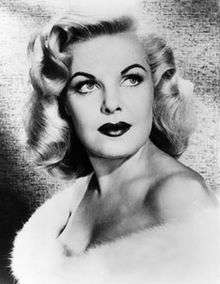Cleo Moore
| Cleo Moore | |
|---|---|
 Moore at the peak of her career (circa 1953) | |
| Born |
Cleouna Moore October 31, 1924 Baton Rouge, Louisiana, U.S. |
| Died |
October 25, 1973 (aged 48) Inglewood, California, U.S. |
| Years active | 1948–1957 |
| Spouse(s) |
Palmer Long (1944, six weeks) Herbert Heftler (1961–1973) |
Cleo Moore (born Cleouna Moore; October 31, 1924 – October 25, 1973) was an American actress, usually seen in the role of a blonde bombshell in Hollywood films of the 1950s.
After being raised in Baton Rouge, Louisiana, and moving to Hollywood in the late 1940s, Moore became a well-known pin-up girl. After breaking into minor films, Moore signed a brief contract with Warner Brothers in 1950. She then signed a two-year deal with RKO Radio Pictures (1950–52), before signing a longer contract with Columbia Pictures in 1952.
At Columbia, Moore was molded as the studio's next resident film star, with the studio hoping to make her "their Marilyn Monroe" or the "new Rita Hayworth". During her time at Columbia, Moore starred in One Girl's Confession (1953), The Other Woman (1954), and Women's Prison (1955). However, Moore's career began to decline when the studio signed Kim Novak to a contract and started focusing on capitalizing her instead of Moore. Moore retired from acting in 1957 after starring in Hit and Run.
Moore died in her sleep at the age of 48 in 1973. Although she never obtained true film stardom, Moore has become a cult fan favorite, with several of her films being considered cult classics.
Early life
Cleouna Moore was born in Baton Rouge, Louisiana, and raised in nearby Gonzales, Louisiana. After high school, she married Palmer Long, the youngest son of the late Louisiana governor Huey Long but the marriage ended within months. She moved with her family to California in 1945, determined to enter motion pictures.
Career
She made her film debut in 1948, playing a small role in Embraceable You. She also played the leading lady in the film serial Congo Bill and worked for Warner Brothers briefly in 1950. She worked for RKO Radio Pictures from 1950–52, making such films as Hunt the Man Down and Gambling House.
She signed with Columbia Pictures in 1952. The studio had plans to mold Moore as their next film star, hoping she would bring Columbia the success that 20th Century-Fox was having with Marilyn Monroe. In order to compete with Monroe, Moore had to bleach her hair platinum blonde. Columbia dubbed her "The Next Big Thing" and "The Blonde Rita Hayworth". She first gained attention as a doomed gun moll in Nicholas Ray's film noir On Dangerous Ground in 1952.
Moore began starring in films in 1952. In 1953, she made one of her most remembered movies, One Girl's Confession, opposite Hugo Haas, who would direct and appear opposite her in several other films. She went on to co-star in Thy Neighbor's Wife (1953), and Bait (1954), both directed by Haas, and the latter co-starring John Agar.
In 1954, she starred in The Other Woman, playing a B-movie bit player, who strikes at her movie director for revenge, when he declines the offer for her to be in his picture. During 1954, Moore's career began to fade in the eyes of Columbia. The studio signed newcomer Kim Novak to a contract and started molding Novak as their new star on the lot and started casting Moore in forgettable B-movies.
Upon completing a supporting role in Women's Prison (1955), Moore signed a brief deal with Universal Pictures, to play a suicidal prostitute in the low-budget thriller, Hold Back Tomorrow (1955), again opposite John Agar.
In 1956, she starred as a predatory career girl in Over-Exposed, co-starring Richard Crenna. The following year, Moore made her final film appearance in Hit and Run (1957). After the release of the film, Moore retired from acting, never to return.
During this period of 1950s Hollywood Moore was one of several buxom blondes to achieve notability following to Marilyn Monroe's major breakthrough; the others including Jayne Mansfield, Mamie Van Doren, Diana Dors, Sheree North, Anita Ekberg, Barbara Lang, Barbara Nichols, Joi Lansing, and Greta Thyssen. In the mid-1950s Columbia considered starring Moore in a film biography on Jean Harlow's life but the project did not come to pass.
Despite never achieving true film stardom, Moore made headlines with several publicity stunts, notably a five-minute kiss on live Chicago television in 1954 and her tongue-in-cheek pledge to one day run for Governor of Louisiana, having been very briefly married in 1944 to Palmer Long, the youngest son of Louisiana kingmaker Huey Long.
Moore began attracting a cult following in the 1980s with the airings of her bad girl movies on television, and particularly among collectors of the posters and memorabilia issued for her films.
In the 1990s, she was dubbed by film historians as the "Queen of the B-Movie Bad Girls" due to her rising popularity with buffs of the film noir genre. Sony Pictures released three Moore titles – Over-Exposed, One Girl's Confession, and Women's Prison – in a DVD set entitled Bad Girls of Film Noir Volume II. The set also included as a bonus feature a 1954 television drama starring Moore.
Personal life
Moore found success as a businesswoman in real estate after her screen career ended in the late 1950s. She married multi-millionaire real estate developer Herbert Heftler in 1961 and lived on an estate on Coldwater Canyon in Beverly Hills for the rest of her life.
She had been out of the limelight for many years when she died in her sleep at home, three days before her 49th birthday. She had three sisters: Mari, Voni, and Jonnie. Moore is interred at Inglewood Park Cemetery, Inglewood, California.
Filmography
|
|